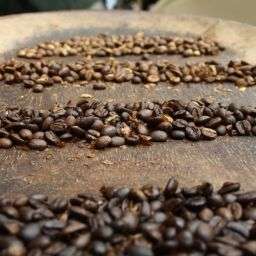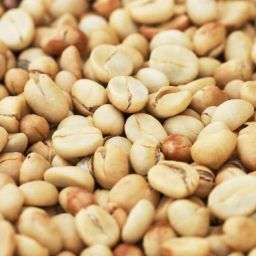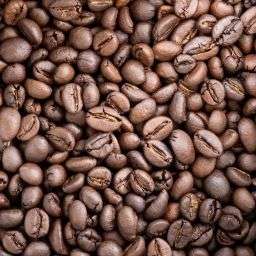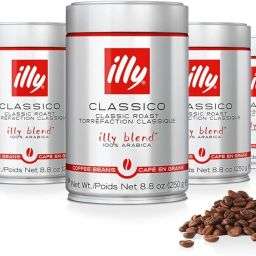
Caramelized coffee beans are the result of a precise roasting process that enhances the natural sugars within the beans, leading to a complex and enriched flavor profile. This process, known as caramelization, occurs between the initial yellowing of the beans and the first crack—a pivotal moment when the beans expand and release their inherent sugars. The transformation imbues the coffee with a rich, sweet depth, distinguishing it from its non-caramelized counterparts.
The Science Behind Caramelization
Caramelization is a chemical reaction that unfolds as the coffee beans are exposed to heat, specifically when temperatures soar between 150°C to 180°C. This phase is crucial for the development of the beans’ aroma and flavor complexity. Unlike the Maillard reaction, which involves amino acids and sugars and starts at a lower temperature, caramelization is a slower process that solely concerns the sugars present in the coffee beans.
As these sugars heat up, they begin to break down and recombine into new compounds, including furfuryl, contributing to a caramel-like aroma. The resulting flavor profile is less sweet but more nuanced, offering a blend of slightly burnt, nutty, and even meaty notes.
Characteristics of Caramelized Coffee Beans
Caramelized coffee beans are celebrated for their enticing aroma and multifaceted taste. The caramelization process not only amplifies the natural sweetness of the coffee but also introduces a spectrum of flavors—ranging from nutty undertones to hints of chocolate.
This delicate balance between sweetness and bitterness enriches the coffee’s overall taste, making each sip a deeply satisfying experience. The expertise of the roaster plays a crucial role in achieving the desired flavor characteristics, as they carefully manage the roasting temperature and duration to unlock the beans’ full potential.
Brewing the Perfect Cup
Brewing caramelized coffee beans demands a thoughtful approach to fully capture their exquisite flavor. Opting for a medium to medium-fine grind size facilitates proper extraction, preventing bitterness. The quality of water is paramount; hence, fresh, filtered water is recommended to ensure a clean taste.
The brewing ratio—generally 1 to 2 tablespoons of coffee grounds per 6 ounces of water—can be adjusted to personal preference. Moreover, maintaining a brewing temperature between 195°F to 205°F (90°C to 96°C) is ideal for optimal flavor extraction. Experimentation with various brewing methods, such as pour-over, French press, espresso, and Aeropress, can reveal different facets of the caramelized beans’ complex flavor profile.
Caramelized Coffee in Culinary Creations
Caramelized coffee beans offer a unique flavor that can elevate a wide range of culinary creations, from decadent desserts to savory dishes. Their rich, complex taste pairs exceptionally well with chocolate, making them a perfect addition to brownies or chocolate cakes, where they add a deep coffee flavor. In ice creams or custards, caramelized coffee beans can introduce a sophisticated, bittersweet note, balancing the sweetness of these desserts.
For a savory twist, finely ground caramelized beans can be used as a rub for meats, imparting a subtle coffee flavor that complements smoky and spicy notes. Additionally, caramelized coffee beans can be a creative topping for salads, adding a crunchy texture and a unique flavor contrast to the fresh ingredients.
DIY Caramelization Techniques
Roasting coffee beans at home allows for customization of the caramelization level to suit personal taste preferences. Begin with high-quality green coffee beans, and choose your roasting method: air roasting, drum roasting, or stove top roasting. Air roasting provides a clean, uniform roast, while drum roasting offers a traditional method that can add complexity to the bean’s flavor profile.
Stove top roasting, using a heavy skillet or pan, is more hands-on and requires constant stirring to ensure even roasting. Regardless of the method, monitor the beans closely for the first crack—a sign that caramelization is occurring. Experiment with different roast times past the first crack to achieve the desired level of caramelization, balancing sweetness and depth of flavor.
Best Caramel Flavored Coffee Beans on the Market
The market is replete with caramel-flavored coffee beans that cater to a range of palates, from sweet and subtle to rich and robust. Among the best are the Independence Caramel, Vanilla, and a Hint of Pecan Flavored Whole Bean, praised for its smooth blend of flavors and high customer satisfaction. Bones Coffee Company offers a Salted Caramel variant that combines the savory taste of salt with the sweetness of caramel, providing a unique and enjoyable experience.
For those who prefer a more chocolate-oriented flavor, Cameron’s Chocolate Caramel Whole Bean is a standout, offering a rich and indulgent coffee experience. These selections and more are available from reputable online retailers, providing coffee aficionados with ample options to enjoy the delightful taste of caramel in their daily brew.
FAQs
Q: Do caramelized coffee beans offer any health benefits?
A: Caramelized coffee beans retain most of the health benefits of regular coffee, including antioxidants and nutrients. However, the caramelization process doesn’t significantly enhance these benefits.
Q: How do caramelized coffee beans differ from regular coffee beans?
A: Caramelized coffee beans undergo a specific roasting process that emphasizes the natural sugars in the beans, resulting in a richer, more complex flavor profile compared to regular beans.
Q: Any tips for storing caramelized coffee beans to preserve freshness?
A: To maintain freshness, store caramelized coffee beans in an airtight container away from direct sunlight and moisture. Avoid refrigeration, as it can introduce moisture and odors.
Summarizing the World of Caramelized Coffee Beans
Caramelized coffee beans stand out for their unique flavor and aromatic richness, offering a gourmet experience that transcends ordinary coffee. Through careful roasting, these beans reveal a symphony of sweet and complex flavors, enhancing both the drinking and culinary experience. Their versatility in pairing with various foods and drinks underscores their appeal to coffee enthusiasts and culinary adventurers alike.









